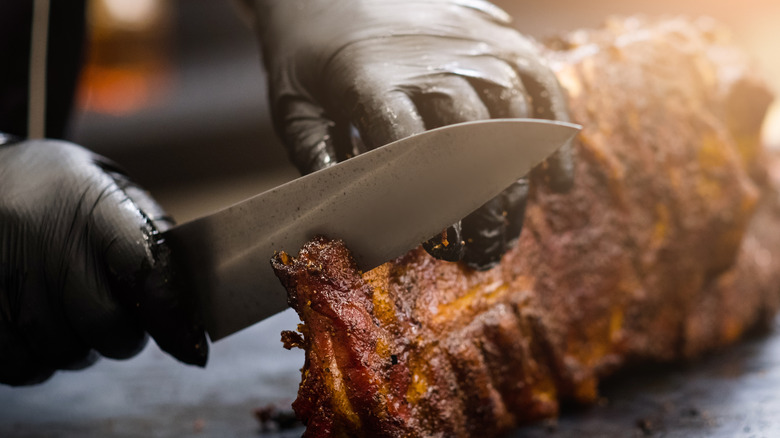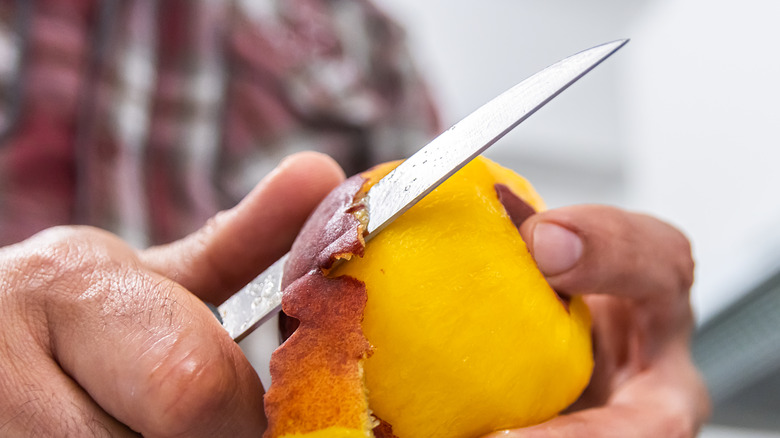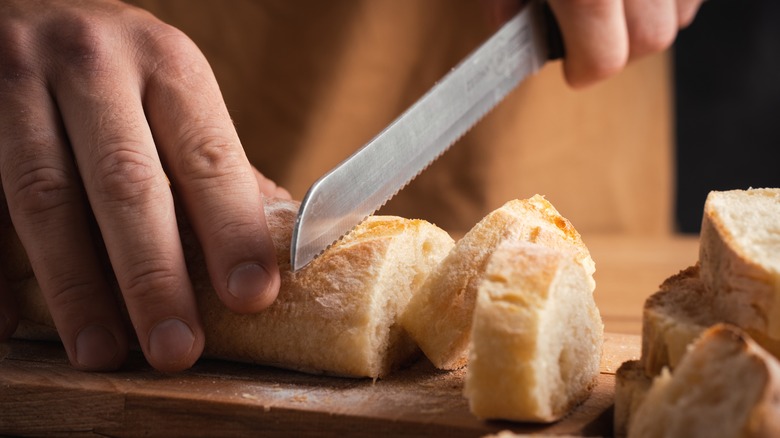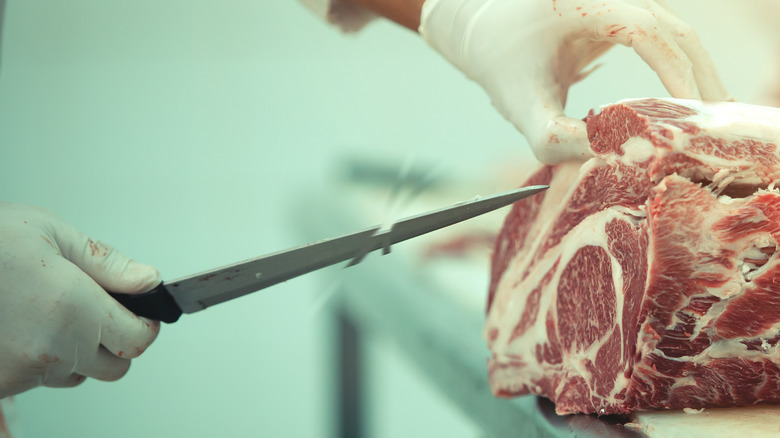The 4 Knives Gordon Ramsay Recommends You Own
How intimidated would you be if you found yourself standing face-to-face with Gordon Ramsay and the only thing separating you was a table full of extremely sharp knives? You'd probably quake in your boots, right? We certainly would. If we're to judge Ramsay solely on his television programs alone, he is not someone to be trifled with. Yet, an element of respect needs to pair with the intimidating personality in order to be taken seriously. If you want to tell people off for doing things wrong, you'd better know what you're doing. Gordon Ramsay knows what he's doing.
According to Gordon Ramsay's official website, the star chef is the holder of seven Michelin Stars, runs an international empire of restaurants, is a bestselling author and hit television presenter, manages a production studio, co-runs a charity, and has hosted not one, but two courses on MasterClass. So, when he recommends the type of kitchen knives he thinks you should own, you listen.
One of the keys to running a successful kitchen, home or professional, is to have a stock of sharp, quality knives. Jacques Pépin has noted on several occasions that sharp knives are not only more efficient, but far safer than dull ones, via KQED. You don't need to have a battalion of second-rate knives. Instead, keep a small number of high quality knives. They will last you far longer and serve you far better. Here are the four Ramsay recommends: chopping, paring, bread, and boning.
The chopping knife aka the chef's knife
On his YouTube channel, Gordon Ramsay has a video explaining three of the four types of knives he keeps in his kitchen. The first is the all purpose chopping knife, or chef's knife. This knife is the benchmark of any kitchen; a heavy-duty tool able to perform a variety of cooking tasks with ease. Commonly sold with an 8-inch blade, a chef's knife is designed to be balanced in such a way that does not require excessive pressure to use, per Huston Press.
As Ramsay says, the chopping knife is excellent for, well, chopping. However, thanks to the utility of the sharp tip and double beveled blade, chopping is hardly all a chef's knife is good for, per Made-In Cookware. The knife's design makes it easy to rock the blade, which is perfect for dicing, mincing, and slicing everything from fruits and vegetables, to meats, nuts, and herbs.
There are several popular styles of chef's knives. Japanese style knives, in particular, are noted for their steel quality and thiner, lightweight blades, per Acit Group. According to MasterClass, Ramsay prefers Henckels knives, which are a German style brand. As Acit Group states, German style chef's knives are noted for their bulky blades that are tough enough to handle the likes of chicken bones owing to their extra heft. Whatever your preferred style, owning a chef's knife is essential if you want an efficient and versatile kitchen.
The paring knife
Contrasting the all-purpose chopping knife is Gordon Ramsay's second recommendation, the paring knife. According to Japanese knife manufacturer Kamikoto, paring knives are intended to do more delicate, specific work such as removing the shell and vein from a shrimp. More every-day tasks include peeling and cutting smaller vegetables and fruits. Note: paring knives are a great option for those without a vegetable peeler.
The short blade, typically between 2.5 to 4.5 inches in length, allows for more control when performing these more detail oriented tasks. The size the paring knife directly dictates its usage. Unlike the chef's knife, the paring knife is not an all purpose vehicle, meaning it is not the best option for cutting meat and larger root vegetables, or slicing bread.
However, the paring knife does come in handy when it comes time to score raw meat or bread dough. According to MasterClass, to score is to cut a slash in the surface of a bread dough before baking. By scoring your loaf of bread, you allow the steam to escape during baking so the dough can expand without cracking. The same is true when scoring meat. Made-In Cookware states that the added cuts on the meats surface will help increase the Maillard reaction, giving you that great crispy sear, and allow any aromatics to marinate deeper. So keep this little knife right next to the big guy. You'll always find use for both.
The bread knife
Now we come to Gordon Ramsay's third recommendation, the bread knife. It's important to specify that this knife is serrated, meaning that instead of a smooth blade the knife is rippled with teeth like a carpentry saw. The purpose of the bread knife is to easily cut through tougher food surfaces, such as bread crust. Using a sawing motion, the teeth are able to tear into the surface of the crust with very little applied pressure. Once the crust is penetrated, the continued sawing motion allows for the crescent moon shaped valley's between each tooth to create a clean cut and an even slice of bread (via Misen).
Despite it's hacksaw-like appearance, a bread knife can actually perform some rather delicate tasks. Kikusumi Knives explains that bread knives are excellent option for cutting into softer desserts. Again owing to the lack of downward pressure needed to use it, the bread knife can help delicate desserts, such as a multilayered cake, maintain their structure far better than a chef's knife or pie server.
Bread knives are also excellent for piercing though the tough outer shell of pumpkins, squash, or pineapples, per Kikusumi. Tomatoes too, while not having rough exteriors, benefit from a serrated blade. A properly sharpened chef's knife will slice through a tomato in a jiffy. But if you're not regularly sharpening your knives, a bread knife is an excellent alternative that won't completely eviscerate your tomato, according to HuffPost.
The boning knife
The fourth and final of Gordon Ramsay's knife recommendations comes to us courtesy of MasterClass. In their list of kitchen essentials, pulled from Ramsay's course, the boning knife is included amongst the usual suspects. While it may seem like an unusual addition to the kitchen, there is some sense to having one. While it is highly convenient to purchase de-boned meat straight from a butcher or grocery store, having a boning knife will give your kitchen an added edge.
Boning knives are not to be confused with filleting knives. While they both have long blades that form a tapered curve and finger guards to protect your hands from the sharp edge, the boning knife is specifically designed to maneuver around bones, slice through cartilage and ligaments, and remove skin from animals, per F.N. Sharp. This makes them a great option for hunters.
While they make separating meat from bones a breeze, a boning knife can serve more than one purpose in your kitchen. As Made-In Cookware explains, the flexibility of the blade makes a boning knife ideal for handling baked goods. They have the length and sharpness to evenly cut the layers for a cake, as well as paring knife style dexterity for shaping pastries, removing the core from cupcakes without harming the overall structure, and cutting/peeling/coring fruits. So, do yourself a favor and get rid of all the old, dull knives cluttering up your drawers, and get these four instead.




